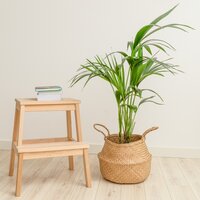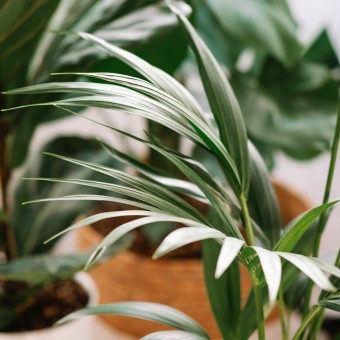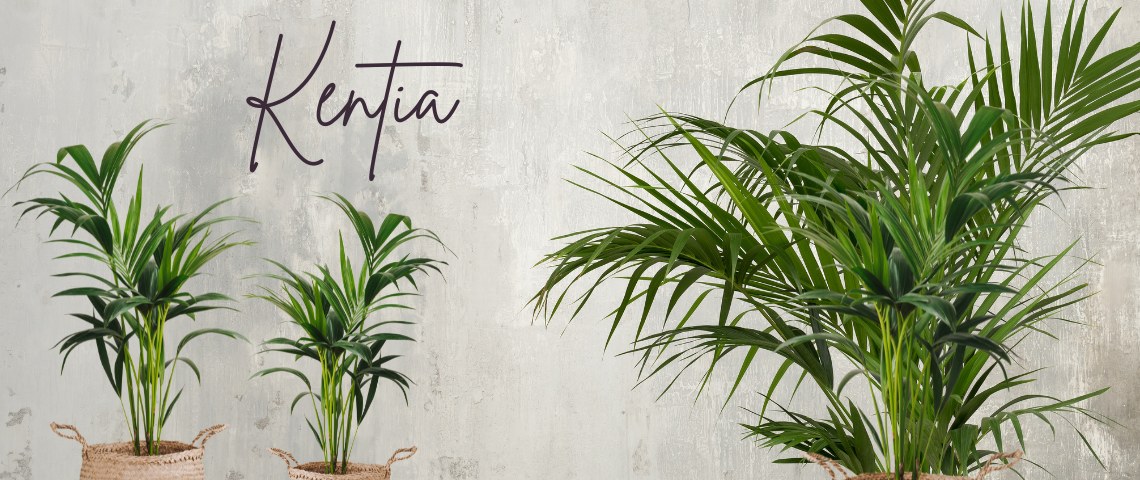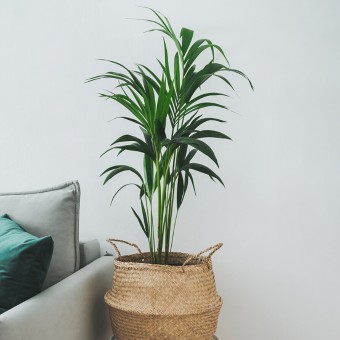-
Kentia care tips for a very happy palm at home!

The Kentia Palm (Howea forsteriana) is a popular indoor plant known for its graceful fronds and ability to thrive in low light conditions. Originating from Lord Howe Island in the South Pacific, this elegant palm adds a touch of tropical charm to any interior space.
If you are lucky enough to have a Kentia Palm in your home or are considering adding one to your collection,
here are some care tips to ensure its health and vitality.

our tips for a great kentia
The Kentia palm (Howea forsteriana) is nowadays one of the most popular houseplants and has always been a very desirable plant. In the care guide you will find detailed information about light, watering, substrate and other things you need to know to care for your areca palm, which are described below.

light conditions
Kentia Palms are known for their tolerance to low light conditions, making them ideal for areas away from direct sunlight. They can survive in low to medium light levels, such as those found in east or west-facing windows with filtered light. However, if possible, placing your Kentia Palm in bright, indirect light will promote its growth and enhance its overall appearance.

watering
One of the keys to successful Kentia Palm care is providing the right amount of water. These plants prefer to be slightly on the drier side, so it's essential to avoid overwatering, which can lead to root rot. Allow the top inch of soil to dry out between waterings and ensure proper drainage to prevent water from sitting at the bottom of the pot. It's better to underwater than overwater, so always check the moisture level before reaching for your watering can.
humidity
Kentia Palms naturally thrive in humid environments, so providing some extra humidity will help maintain their lush appearance. Misting the fronds regularly or placing the plant on a tray filled with pebbles and water can create a humid microclimate around the plant. You can also use a room humidifier to increase the overall humidity in the area.
temperature
Kentia Palms prefer an average room temperature between 60-75°F (15-24°C). They are sensitive to cold drafts, so make sure to keep them away from windows and doors that may let in chilly air during winter months. Avoid placing your Kentia Palm near heating or cooling vents, as sudden temperature changes can stress the plant.
soil
Kentia palms prefer loamy or well-drained little sandy soil. They have the capacity to addapt to clay soils, but take care for adequate drainage - otherwise, they don't tend to grow very well. They tolerate neutral and slightly acidic pH but tend to thrive in medium acidic soil. As mentioned above, this species is characterised by its ability to purify the air, which is why it needs a soil in perfect conditions for its growth. During spring and summer months it's advisable to fertilise it once a month with fertiliser for tropical plants or green plants.
fertilisation
Feed your Kentia Palm with a balanced, water-soluble fertiliser during the growing season (spring and summer) to provide it with essential nutrients. Dilute the fertilizer to half or a quarter of the recommended strength and apply it every four to six weeks. During the dormant period (fall and winter), reduce or suspend fertilisation to allow the plant to rest.
pruning
As the Kentia Palm grows, it's normal for older fronds to yellow and die off. To maintain its appearance, you can prune these brown or yellow leaves by carefully cutting them off at the base. Avoid removing too many fronds at once, as this may harm the plant's overall health.

repotting
Kentia Palms are slow-growing plants and only require repotting every few years when they become root-bound. Choose a pot that is one size larger and use a well-draining potting mix to ensure proper drainage. During repotting, avoid burying the palm too deep in the new pot, as this may cause the stem to rot.
find your palm tree at our webshop!
By following these care tips, your Kentia Palm will flourish and bring a touch of natural beauty to your indoor space. Remember to be patient, as these palms are slow growers, but their graceful presence is worth the wait. With the right conditions and care, your Kentia Palm can become a stunning focal point in your home, reminding you of tranquil tropical destinations.
No comments found.